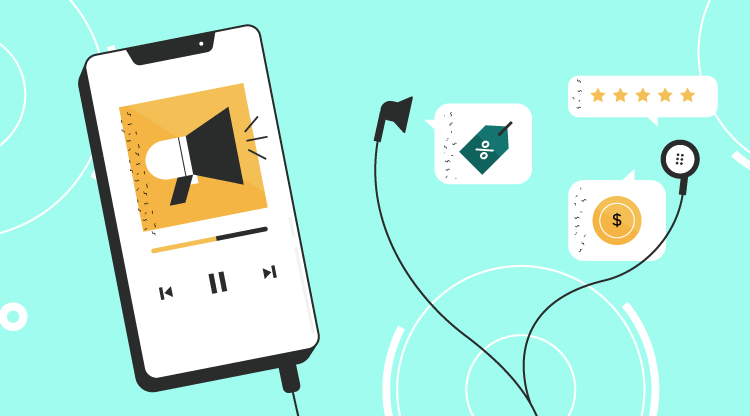In recent years, podcasts have surged in popularity, and with this growth has come a new avenue for advertisers: podcast ads. If you’re curious about how podcast ads work and why they might be an effective tool for reaching audiences, this article will provide a clear overview.
What Are Podcast Ads?
Podcast ads are audio advertisements present in podcast episodes. The host can either read them live or pre-record and insert them into the podcast. These ads are a way for businesses to promote their products or services to podcast listeners, leveraging the show’s audience and content to create a more engaging ad experience.
Why Are Podcast Ads Popular?
1. Growing Audience
Podcasts have become a significant part of the media landscape. With millions of people tuning in every day, advertisers see this as an opportunity to reach a wide and diverse audience. According to recent statistics, over 80 million people in the U.S. listen to podcasts monthly. This vast audience offers a valuable market for businesses.
2. Targeted Advertising
One of the main benefits of podcast ads is their ability to target specific demographics. Many podcasts cater to niche topics and have dedicated audiences. For example, a podcast about gardening will attract listeners interested in plants and gardening. Advertisers can use this to their advantage by placing ads that align with the interests of the audience, leading to more effective and relevant marketing.
3. Engaged Audience
Podcast listeners actively engage with the content. They often listen to podcasts in a focused manner, which means they are more likely to pay attention to ads. Unlike traditional radio or TV ads, which listeners can skip or ignore, podcast ads integrate more seamlessly into the content, making them less intrusive and more engaging.
Types of Podcast Ads
1. Host-Read Ads
Host-read ads are when the podcast host reads the advertisement themselves. The host can either read these ads live during the recording or pre-record them and insert them into the episode. Host-read ads often feel more personal and authentic, as the host’s endorsement lends credibility to the product or service being advertised.
2. Pre-Roll, Mid-Roll, and Post-Roll Ads
Podcast ads can be placed at different points in the episode:
- Pre-Roll Ads: These are played at the beginning of the podcast episode. They catch listeners’ attention right from the start but may be skipped if the listener is eager to dive into the content.
- Mid-Roll Ads: These ads are inserted in the middle of the episode. They are often more effective as listeners are already engaged with the content, making them more receptive to the advertisement.
- Post-Roll Ads: Played at the end of the episode, these ads are usually less effective as listeners may drop off before the episode concludes.
3. Dynamic Ad Insertion
Dynamic ad insertion technology lets you insert ads into podcasts at different times, even after releasing the episode. This therefore means advertisers can update ads or insert new ones into older episodes, increasing the lifespan and relevance of their advertising efforts.
Benefits of Podcast Ads
1. Personal Connection
Podcast hosts often build strong relationships with their audiences. When a host endorses a product, it can feel more genuine to listeners compared to traditional ads. This personal touch can make the ad more persuasive and effective.
2. Less Ad Fatigue
Podcast listeners generally experience less ad fatigue because podcast ads are less frequent and often more relevant. Unlike commercial breaks on TV or radio, podcast ads are typically fewer in number, which helps maintain listener interest.
3. Measurable Results
Advertisers can track the performance of podcast ads through metrics such as downloads, listens, and listener engagement. This data helps in evaluating the effectiveness of the ads and adjusting strategies accordingly.
Challenges of Podcast Ads
1. Ad Skipping
Despite their effectiveness, podcast ads are not immune to ad skipping. Some platforms allow listeners to skip ads, which can then reduce the reach of the advertisement. However, because podcasts often integrate ads into the content, listeners skip them less frequently compared to other media.
2. Cost
Podcast advertising can be expensive, especially for popular podcasts with large audiences. The cost can vary based on the podcast’s reach, the length of the ad, as well as the placement within the episode.
3. Content Control
When placing advertisements in a podcast, advertisers must trust that the podcast host will present the ad in a manner that aligns with their brand’s image. Misalignment between the podcast content and the ad can further affect the effectiveness of the advertisement.
Conclusion

Podcast ads indeed offer a unique and effective way for businesses to connect with their target audience. With the ability to reach engaged listeners and tailor ads to specific interests, podcasts present a valuable opportunity for advertisers, indeed. By understanding the different types of podcast advertisements and also their benefits and challenges, businesses can make informed decisions on how best to leverage this growing medium for their marketing efforts.
Frequently Asked Questions (FAQs)
1. What are podcast ads and how do they work?
Podcast ads are audio advertisements placed within podcast episodes. They can be read by the podcast host or pre-recorded. These ads target specific audiences based on the podcast’s content, aiming to reach engaged listeners during their listening experience.
2. What are the different types?
The main types of podcast ads include host-read ads, where the host reads the ad, and pre-recorded ads. You can place ads at different points in the episode: pre-roll (beginning), mid-roll (middle), and post-roll (end). Dynamic ad insertion lets you update or insert ads into older episodes.
3. How can I measure their effectiveness?
You can measure the effectiveness through metrics such as the number of downloads, listens, and listener engagement. Tracking tools and analytics provided by podcast platforms help assess how well the ad performed and further its impact on your target audience.
4. What are the main challenges associated with such ads?
Challenges include potential ad skipping by listeners, varying costs based on podcast popularity, as well as ensuring that the ad aligns with the podcast’s content. Additionally, if the ad placement or content doesn’t integrate well, you may struggle to maintain relevance and effectiveness.


